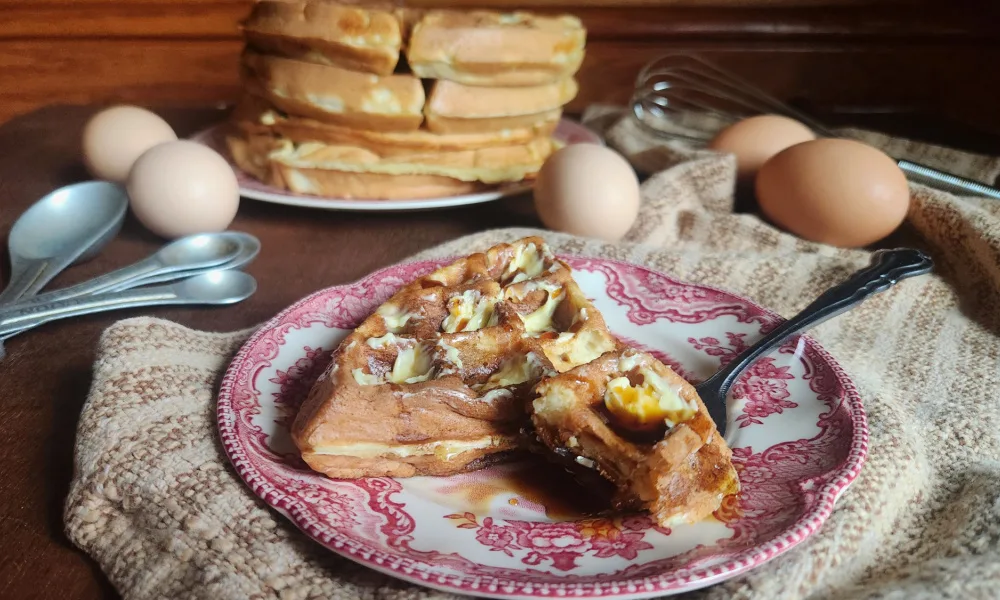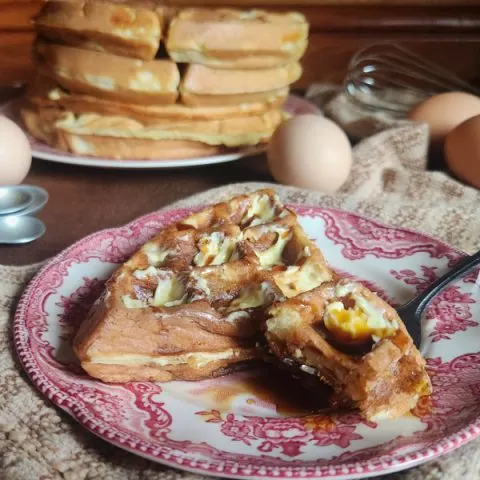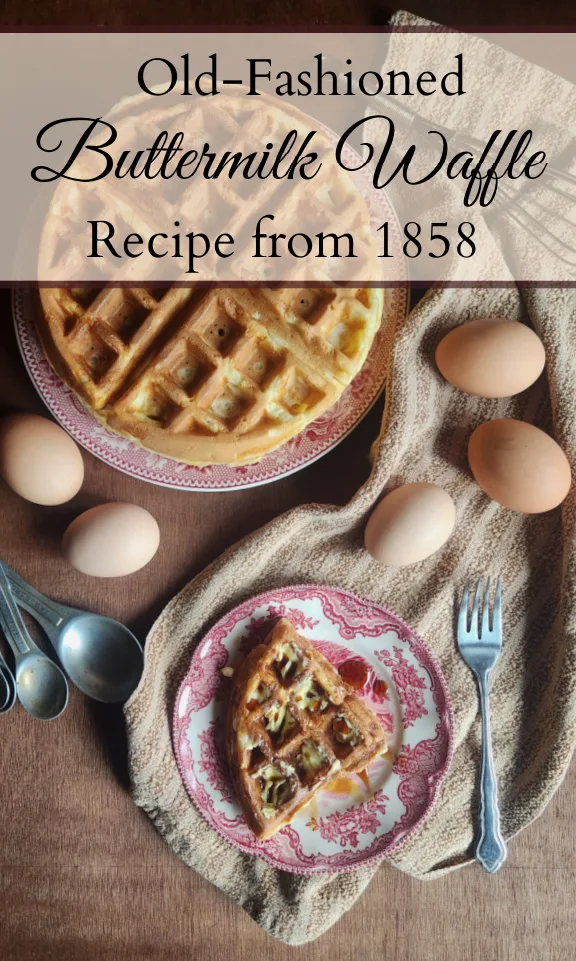(Affiliate disclosure: I may receive a commission if you purchase something through links in this post. As an Amazon Associate I earn from qualifying puchases. See more details here:)

Light and fluffy waffles are one of my favorite breakfast foods, but until recently they aren’t something that I would have necessarily associated with 19th century cooking, so I was pretty excited recently when I found an old-fashioned buttermilk waffle recipe from the 1850s.
I wasn’t sure what to expect when I tried out this recipe because sometimes old recipes can be hit or miss when it comes to how successful they are. I didn’t know if they would turn out really dense or flat or if they would have some other issue, but I was pleased with both the texture and flavor of these waffles. The texture seemed just as light and fluffy to me as other modern waffles I’ve tried, and the flavor is mildly sweet and neutral enough to pair well with any toppings you might wish to add.
The Original 19th Century Recipe
Here is the original recipe from Miss Beecher’s Domestic Receipt-Book:
“One quart of flour, and a teaspoonful of salt. One quart of sour milk, with two tablespoonfuls of butter melted in it. Five well-beaten eggs. A teaspoonful or more of saleratus, enough to sweeten the milk. Baked in waffle irons. Some like one tea-cup full of sugar added.”
Miss Beecher’s Domestic Receipt-Book, pg. 96
I decided to divide this recipe in half, so I cut all of the ingredients in two except for the eggs. Rather than trying to divide an egg in half I just decided to use three eggs instead. The original recipe also calls for sour milk which would have been raw unpasteurized milk that had soured or cultured naturally by being out at room temperature rather than being refrigerated. This isn’t the same as pasteurized milk that has spoiled or gone bad. If you have access to good quality raw milk that has been unrefrigerated long enough to go sour then this recipe would be a perfect use for that if you want to make an even more authentic version of this recipe. If you don’t have access to raw milk, though, modern cultured buttermilk works perfectly well as a substitute.
The biggest difference that I noticed between this old-fashioned 19th century waffle recipe and other more modern waffle recipes is the lack of vanilla flavoring. Vanilla wasn’t commonly used until later on in the 19th century, so at the time when this cookbook was published other flavorings were often used such as spices, rosewater, lemon, etc.
In the 19th century, waffle irons would most likely have been true irons made from cast iron like a cast iron skillet. You can use any modern waffle maker to make these waffles, though. This waffle maker with removeable plates is the one that I’ve been using. I love the fact that you can take the grid plates out to wash them either by hand or in the dishwasher, so cleaning up after making waffles is so much easier than the waffle maker I had used previously that didn’t have removeable plates.
How to Serve These Waffles
These waffles have a mildly sweet, neutral flavor, so they can pair well with whatever flavorings or toppings you might like to add. The original recipe doesn’t mention anything about suggestions for serving these waffles, but you can serve them anyway you choose. My personal preference is to top them with plenty of good butter and pure maple syrup, but you could also sift some sugar or maple sugar over them along with some cinnamon or other spices, or you could top them with fresh berries or a berry syrup, etc. You could even try adding a pinch more salt to the recipe and omit a couple of tablespoons of the sugar to take these in a more savory direction and top them with savory toppings instead of the usual sweet ones.
This recipe makes six round waffles that are 7 inches in diameter, so you will end up with 24 triangular sections. Depending on how many people you are making the waffles for, you can store extras in the fridge and then put them in the toaster to reheat them, or you can also break them up into individual sections and put them in a freezer bag with pieces of parchment paper in between so they don’t stick together. And then you can take out a section at a time as needed whenever you want a waffle. I found that they defrost well in the toaster. (You might just have to experiment a bit with the settings to find out how long to toast them for so that they defrost and get crispy again.)

Old-Fashioned Buttermilk Waffle Recipe from 1858
These light and fluffy old-fashioned buttermilk waffles have a mildly sweet flavor that pairs well with butter and pure maple syrup or with any other toppings that you like. This recipe is adapted from Miss Beecher's Domestic Receipt-Book from 1858.
Ingredients
- 2 cups flour (I used unbleached all-purpose flour)
- 1/2 tsp. salt
- 2 cups buttermilk
- 1 Tbs. melted butter (I used salted butter)
- 3 eggs
- 3/4 tsp. baking soda
- 6 Tbs. sugar
Instructions
- In a large mixing bowl combine flour, salt, sugar, and baking soda and stir well to combine.
- Melt the butter and add it to the bowl along with the buttermilk.
- Crack the eggs into a separate bowl and beat them together with a spoon or fork for a minute or two and then add them to the larger mixing bowl with the rest of the ingredients.
- Stir all of the ingredients together well to combine.
- Using the instructions specific to your particular waffle maker, lightly grease the waffle maker if needed and spoon batter into the waffle irons, gently spreading it around to fill each section.
- Cook each waffle for approximately 3-5 minutes or until the waffle reaches your desired level of crispiness. Cooking times will vary based on individual waffle makers.
Notes
This waffle recipe doesn't include vanilla extract because it wasn't a common flavoring at the time the recipe was written. If you want a more modern tasting waffle you can add a splash of vanilla extract if you like.

(We are a participant in the Amazon Services LLC Associates Program, an affiliate advertising program designed to provide a means for us to earn fees by linking to Amazon.com and affiliated sites.)
The information in this post is not to be taken as medical advice and is not intended to diagnose or treat any disease.


William Post
Wednesday 17th of April 2024
Hi Lori. I had to look up saleratus! Should have looked at the recipe first. Another flavoring that was popular in those days was nutmeg. Great research.
Lori Elliott
Wednesday 17th of April 2024
It's really interesting to see the difference in ingredients (or in ingredient names like saleratus) between older recipes and modern ones. And, yes, nutmeg seems like it must have been very popular back then! I see it all the time whenever I look through older cookbooks.